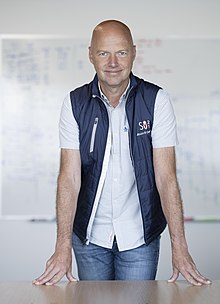
Back سيباستيان ثون ARZ Sebastian Thrun German Sebastian Thrun Spanish Sebastian Thrun French セバスチアン・スラン Japanese Sebastian Thrun Portuguese Трун, Себастьян Russian Sebastian Thrun Swedish Себастьян Трун Ukrainian Sebastian Thrun Uzbek
Sebastian Thrun | |
|---|---|
 Thrun in 2021 | |
| Born | May 14, 1967 |
| Citizenship | United States, Germany |
| Alma mater | University of Bonn University of Hildesheim |
| Awards | National Science Foundation CAREER Award (2003) AAAI Fellow (2006) DARPA Grand Challenge (2005) |
| Scientific career | |
| Fields | Artificial Intelligence[1] Robotics[2] |
| Institutions | Google X Lab (founder) Stanford University Carnegie Mellon University Udacity (co-founder) |
| Thesis | Explanation-Based Neural Network Learning: A Lifelong Learning Approach (1995) |
| Doctoral advisor | Armin B. Cremers Tom Mitchell[3] |
| Doctoral students | Frank Dellaert[3] John Langford[3] Joëlle Pineau David Stavens[3] |
| Website | robots |
| Signature | |
 | |
Sebastian Thrun (born May 14, 1967) is a German-American entrepreneur, educator, and computer scientist. He is CEO of Kitty Hawk Corporation, and chairman and co-founder of Udacity. Before that, he was a Google VP and Fellow, a Professor of Computer Science at Stanford University, and before that at Carnegie Mellon University. At Google, he founded Google X and Google's self-driving car team. He is also an adjunct professor at Stanford University and at Georgia Tech.[4]
Thrun led development of the robotic vehicle Stanley[5] which won the 2005 DARPA Grand Challenge, and which has since been placed on exhibit in the Smithsonian Institution's National Museum of American History. His team also developed a vehicle called Junior,[6] which placed second at the DARPA Urban Challenge in 2007. Thrun led the development of the Google self-driving car.[7]
Thrun is also well known for his work on probabilistic algorithms for robotics with applications including robot localization[8] and robotic mapping.[9] In recognition of his contributions, and at the age of 39, he was elected into the National Academy of Engineering and also into the Academy of Sciences Leopoldina in 2007. The Guardian recognized him as one of 20 "fighters for internet freedom".[10]
- ^ Thrun, S. (2002). "Probabilistic robotics" (PDF). Communications of the ACM. 45 (3): 52–57. doi:10.1145/504729.504754. S2CID 14552983.
- ^ Nigam, K.; McCallum, A. K.; Thrun, S.; Mitchell, T. (2000). "Text Classification from Labeled and Unlabeled Documents using EM" (PDF). Machine Learning. 39 (2/3): 103. doi:10.1023/A:1007692713085. S2CID 686980.
- ^ a b c d Sebastian Thrun at the Mathematics Genealogy Project Retrieved December 12, 2015.
- ^ "Sebastian Thrun | Georgia Tech – College of Computing". Georgia Tech. Retrieved January 17, 2019.
- ^ Thrun, S. et al., Thrun, Sebastian; Montemerlo, Mike; Dahlkamp, Hendrik; Stavens, David; Aron, Andrei; Diebel, James; Fong, Philip; Gale, John; Halpenny, Morgan; Hoffmann, Gabriel; Lau, Kenny; Oakley, Celia; Palatucci, Mark; Pratt, Vaughan; Stang, Pascal; Strohband, Sven; Dupont, Cedric; Jendrossek, Lars-Erik; Koelen, Christian; Markey, Charles; Rummel, Carlo; Van Niekerk, Joe; Jensen, Eric; Alessandrini, Philippe; Bradski, Gary; Davies, Bob; Ettinger, Scott; Kaehler, Adrian; Nefian, Ara; Mahoney, Pamela (2007). "Stanley: The Robot That Won the DARPA Grand Challenge". The 2005 DARPA Grand Challenge. Springer Tracts in Advanced Robotics. Vol. 36. pp. 1–43. doi:10.1007/978-3-540-73429-1_1. ISBN 978-3-540-73428-4.
- ^ Montemerlo, M. et al., Montemerlo, Michael; Becker, Jan; Bhat, Suhrid; Dahlkamp, Hendrik; Dolgov, Dmitri; Ettinger, Scott; Haehnel, Dirk; Hilden, Tim; Hoffmann, Gabe; Huhnke, Burkhard; Johnston, Doug; Klumpp, Stefan; Langer, Dirk; Levandowski, Anthony; Levinson, Jesse; Marcil, Julien; Orenstein, David; Paefgen, Johannes; Penny, Isaac; Petrovskaya, Anna; Pflueger, Mike; Stanek, Ganymed; Stavens, David; Vogt, Antone; Thrun, Sebastian (2009). "Junior: The Stanford Entry in the Urban Challenge". The DARPA Urban Challenge. Springer Tracts in Advanced Robotics. Vol. 56. pp. 91–123. doi:10.1007/978-3-642-03991-1_3. ISBN 978-3-642-03990-4.
- ^ Markoff, John (October 9, 2010). "Google Cars Drive Themselves, in Traffic". The New York Times. Retrieved January 17, 2019.
- ^ "ICRA Brochure 2020" (PDF).
- ^ Robotic mapping: a survey by Sebastian Thrun in Nebel, Bernhard; Lakemeyer, Gerhard (2002). Exploring Artificial Intelligence in the New Millennium (The Morgan Kaufmann Series in Artificial Intelligence). San Diego: Morgan Kaufmann. ISBN 1-55860-811-7.
- ^ Ball, James (April 20, 2012). "The Guardian's Open 20: fighters for internet freedom". The Guardian. Retrieved January 17, 2019.